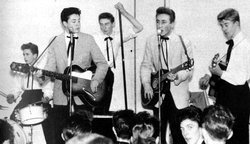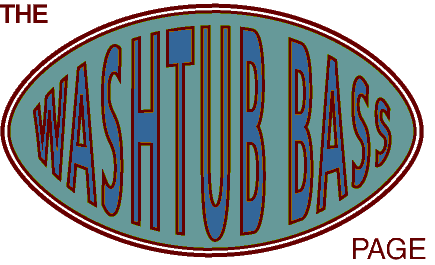- In his fascinating autobiography I am The Blues
(Da Capo Press, 1989) master bluesman Willie Dixon says his first bass, made for him by guitarist Leonard Caston, used what he refers to as an "oil can" or "fuel can" as sound chamber. This must have been one of those old kerosene (sometimes called "fuel oil") drums that were flat on both ends and had no spout. Such a bass is shown in Picture 100 in The WTB Gallery, being played by Dewey Corley, of the Beale Street Jug Band.
- Joe MacDonald (Country Joe) notes that Country Joe and the Fish began as a folk-rock trio featuring washtub bass.
- In England and in Australia, the concept of the WTB is often represented by the "tea-chest bass", made from a wooden packing crate rather than a metal tub. These are said to sound both good and loud, but you need to be limber to play one, I'd say-- the crate stands a couple of feet tall and you put your foot on top to hold it down. (See The Plonkers' bass, Pic #15 in the WTB Picture Gallery.) Such a bass was used by The Quarrymen, Beatle John Lennon's first musical group, back in 1957.

- Contrary to what you might imagine-- given the strong association between skiffle music and the tea-chest bass-- skiffle ambassador Lonnie Donegan apparently did not use either a tea-chest or a tub bass in his numerous skiffle recordings. Interestly enough, the center of the skiffle world appears to have shifted to Germany, where there are dozens of skiffle groups (and the tea-chest is the bass resonator of choice.)
- I was astonished to read, in Fletcher & Rossing's Physics of Musical Instruments, that if the string of an instrument pulls up from the soundboard (read: tub head) at 90 degrees (i.e. perpendicular), then the pitch you hear is not the vibrating frequency of the string, but rather twice that frequency! Vibration of the head is generated by change in string length (twice per cycle) rather than by movement of the string in its plane of vibration.
- "Gut bucket bass" is another name for the washtub bass. Some say the term "gut bucket" refers to a container used to catch booze spilled from a spigot in a barrelhouse. I don't question that the term was applied to such a catch-basin, but I'll bet you a pound of mountain oysters that the term first referred to a container that the cook toted in with a mess of tripe or chittlin's ready for the juke-joint's grill.
- Jimmie Fadden, guitarist/vocalist with The [Nitty Gritty] Dirt Band (and one of the original members), played washtub bass back in 1966-69, during which time the group recorded the Ricochet, Rare Junk,and Alive albums-- although I'm uncertain what cuts the tub is used on.
- Back in the early 70s, I was treated to a demonstration, by none other than Mr. Barcus and Mr. Berry, of the way in which their newly invented pickup could elicit musical qualities from a cardboard box. This may be an unexplored angle in the story of the washtub bass...
Update (two years later): D.E. Wunsch reports witnessing an actual cardboard-box bass, at a music fest in Kissimmee, Florida, although the CBBassist "wasn't using a pick-up. He told me you need a stiff new box, not a tired old box. He said he could get about 5 or 6 hours playing time out of a box. I think he was using an eye bolt and 2 big fender washers to anchor the string. He must have also had some kind of stiffener where his stick rested at the edge of the box, but I don't remember what he used. As best I remember, he didn't raise the edge of the box off the ground"
- Creedence Clearwater Revival's Willy and the Poorboys album cover has a picture of the band with a washtub bass, which bassist Stu Cook played (I think) on the cuts "Poorboy Shuffle" and "Feelin' Blue".
|
|









